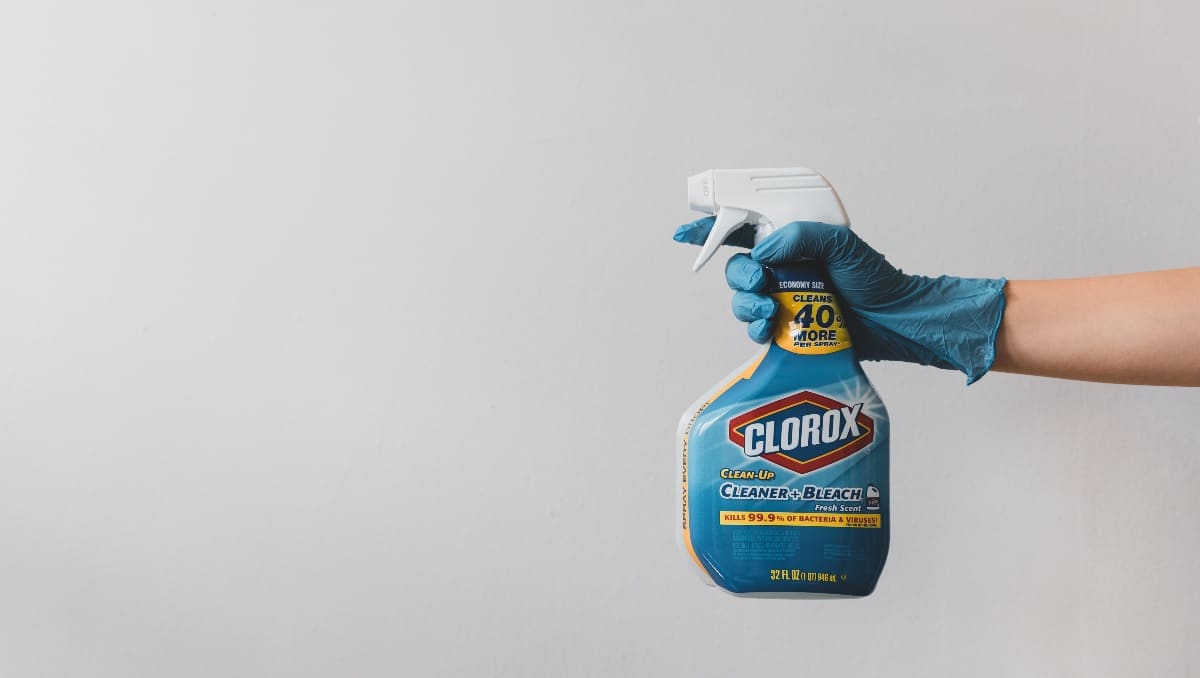Do you ever wonder if the products you use to keep your home clean and safe could actually be harmful to your health? One such product that has been a staple in many households for decades is bleach. But with all its disinfecting power, a lingering question remains: does cleaning with bleach cause cancer?
Cleaning with bleach has been associated with potential health risks, including an increased risk of cancer. The active ingredients in bleach, such as sodium hypochlorite, can produce harmful byproducts when mixed with other common household chemicals.
In this article, we will delve into the composition of bleach and how it interacts with our bodies. We will explore the findings from scientific studies that have investigated the association between bleach exposure and cancer.
Understanding Bleach and Its Composition
Bleach, a commonly used household cleaning agent, is composed of water and sodium hypochlorite. It is important to note that the concentration of sodium hypochlorite can vary depending on the type of bleach being used.
When used properly, bleach can effectively disinfect surfaces and kill germs.
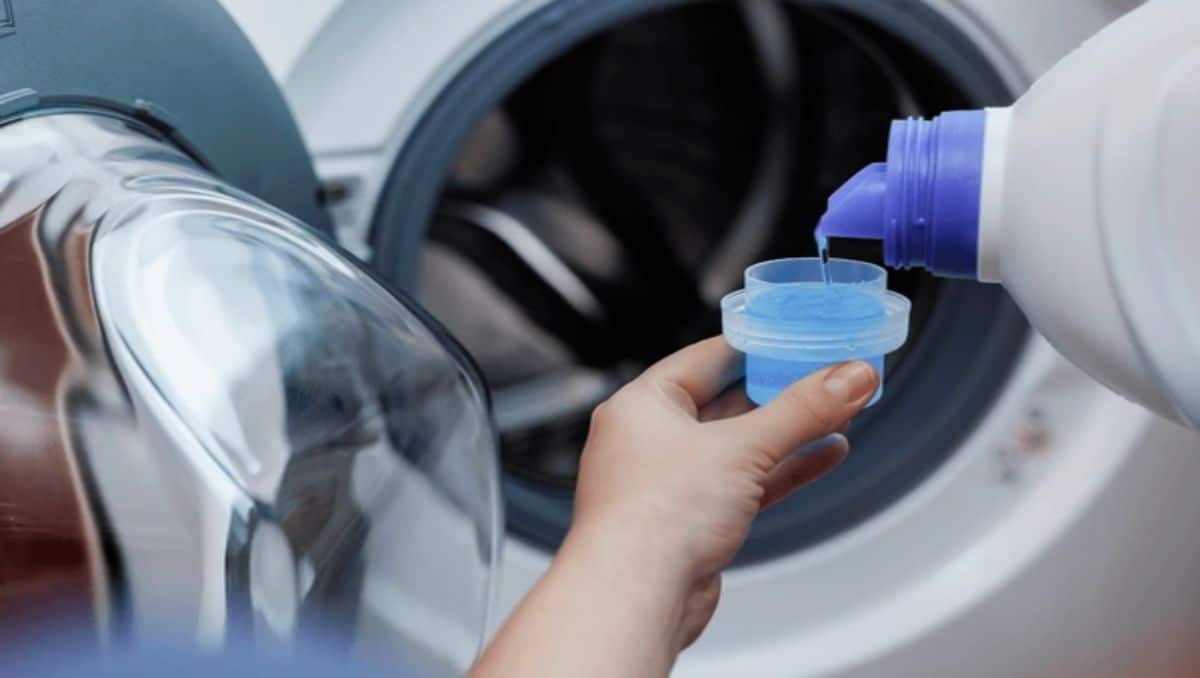
Chemical Composition of Bleach
With its potent mix of chemicals, bleach transforms into a powerful agent that can create a sparkling, clean environment. Understanding bleach toxicity is crucial to ensuring proper handling and safety precautions.
Bleach contains sodium hypochlorite, a strong oxidizing agent that reacts with organic materials, such as dirt and stains, breaking them down and removing them from surfaces. This chemical reaction helps eliminate bacteria, viruses, and other harmful microorganisms.
It is important to recognize the potential health effects associated with bleach exposure. It is recommended to use bleach in well-ventilated areas, wear protective clothing and gloves when handling it, and follow proper dilution instructions for safe usage.
Common Household Uses of Bleach
To keep your home clean and free from germs, you can use bleach in various ways.
For example, you can disinfect countertops, kill mold and mildew in the bathroom, and whiten your laundry. However, if you prefer not to use bleach or are looking for eco-friendly bleach alternatives, there are other options available.
When using bleach in the kitchen, it is recommended to dilute it properly and avoid mixing it with other cleaning products to prevent harmful chemical reactions.
While bleach can be effective at killing germs, it is also important to consider its potential impact on respiratory health and the environment.
Here’s a table summarizing the common household uses of bleach:
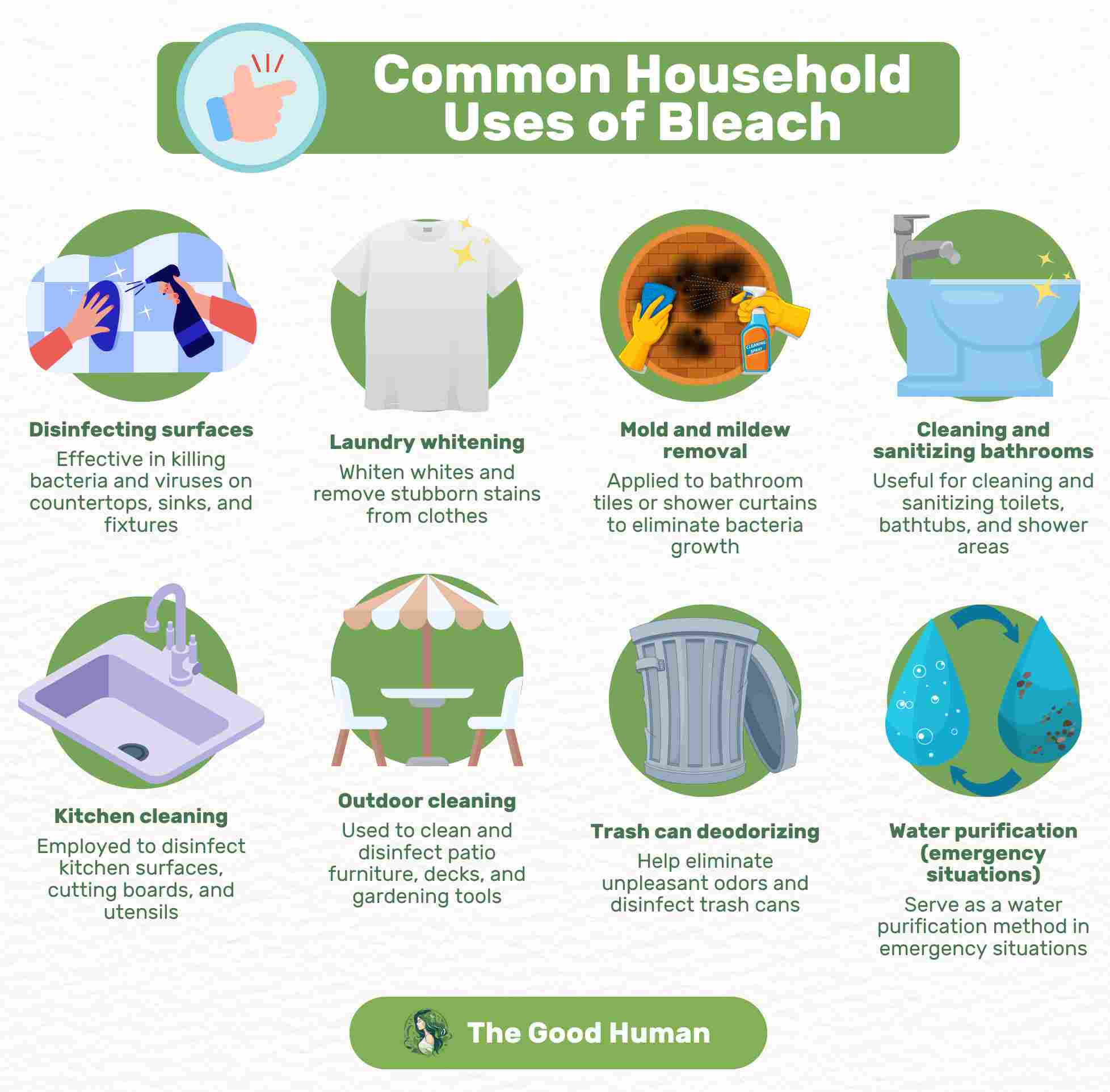
Bleach and Cancer: What Studies Say
Although studies on the topic are still ongoing, there is evidence suggesting a potential link between cleaning with bleach and an increased risk of developing certain types of cancer.
Bleach studies have looked at the health effects of exposure to this commonly used household product. In one study, researchers discovered that women who reported using bleach for cleaning at least once a week had a higher risk of developing respiratory conditions like asthma and chronic obstructive pulmonary disease (COPD).
Another study published in the National Library of Medicine examined occupational exposure to bleach among healthcare workers and found an increased risk of developing certain cancers, such as lung cancer and bladder cancer.
Exposure assessment studies have also been conducted to better understand how people may come into contact with bleach and its potential health risks. These studies have identified various routes of exposure, including inhalation, skin contact, and ingestion.
It is important to note that while these studies suggest a potential link between cleaning with bleach and cancer risk, they do not prove causation.
Although further research is needed to fully understand the relationship between cleaning with bleach and cancer risk, current evidence suggests a potential association. It is important for individuals to take precautions when using bleach products to minimize any potential harmful effects on their health.
Assessing Individual Risk Factors
When assessing individual risk factors for the potential link between cleaning with bleach and cancer, there are several key points to consider.
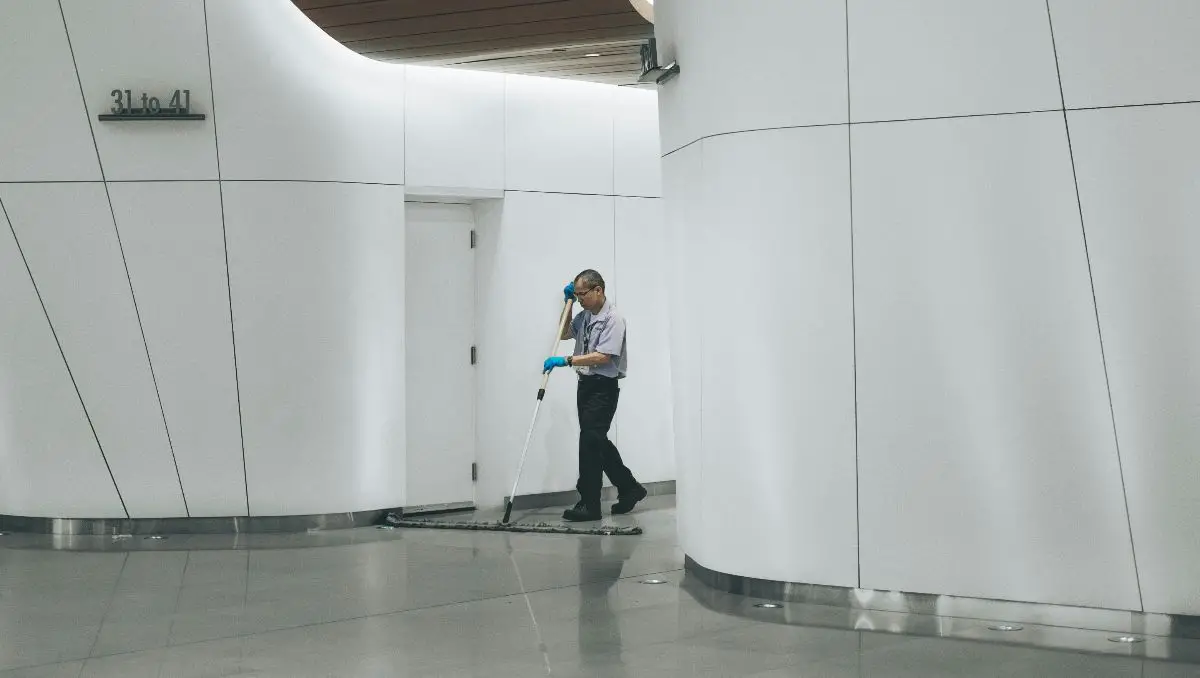
Occupational Exposure
Occupational exposure to cleaning with bleach can potentially increase the risk of developing cancer. It is important to be aware of the occupational hazards associated with working with bleach and to take the necessary precautions. Safety guidelines should be followed, including wearing protective equipment such as gloves, goggles, and masks.
Employers have legal responsibilities to provide a safe work environment and ensure that employees are properly trained on handling chemical substances like bleach. Occupational exposure to bleach has health implications that shouldn’t be ignored or underestimated.
It is crucial for both employers and employees to prioritize safety when working with chemicals like bleach in order to protect against potential health risks.
Frequency and Duration of Exposure
Assessing the effects of occupational hazards requires understanding both the duration and frequency of exposure.
The more frequently you are exposed to bleach, the higher your risk may be. Additionally, studies have shown that individuals who are exposed to bleach on a regular basis for long periods of time may experience adverse health effects.
However, it is essential to note that individual susceptibility plays a role in determining the impact of bleach exposure on cancer development.
Pre-existing Health Conditions
It is important to consider if you have any pre-existing health conditions that could potentially be exacerbated by exposure to cleaning agents containing bleach.
Underlying conditions such as asthma, chronic obstructive pulmonary disease (COPD), or other respiratory issues could make you more susceptible to the health implications of bleach exposure. These individuals may experience worsened symptoms, including difficulty breathing or irritation of the airways.
Preventative strategies such as using alternative cleaning products or ensuring proper ventilation can help minimize the potential negative effects on their health.
Age and Genetics
Age and genetic factors can play a significant role in determining an individual’s susceptibility to certain diseases, including cancer. While there isn’t any direct evidence linking the use of bleach to cancer development, it is crucial to consider these risk factors when evaluating overall health.
Age and genetics may indirectly influence one’s vulnerability to certain health conditions, including respiratory issues or skin sensitivity, which could contribute to the overall impact of bleach exposure.
However, more research is needed to clearly define the interplay between age, genetics, and the specific risks of cancer associated with them. Regardless of age or genetics, practicing cancer prevention strategies is vital.
Common Bleach Exposure Scenarios
When assessing the risks associated with bleach exposure, it is important to consider common scenarios, such as inhalation during cleaning.
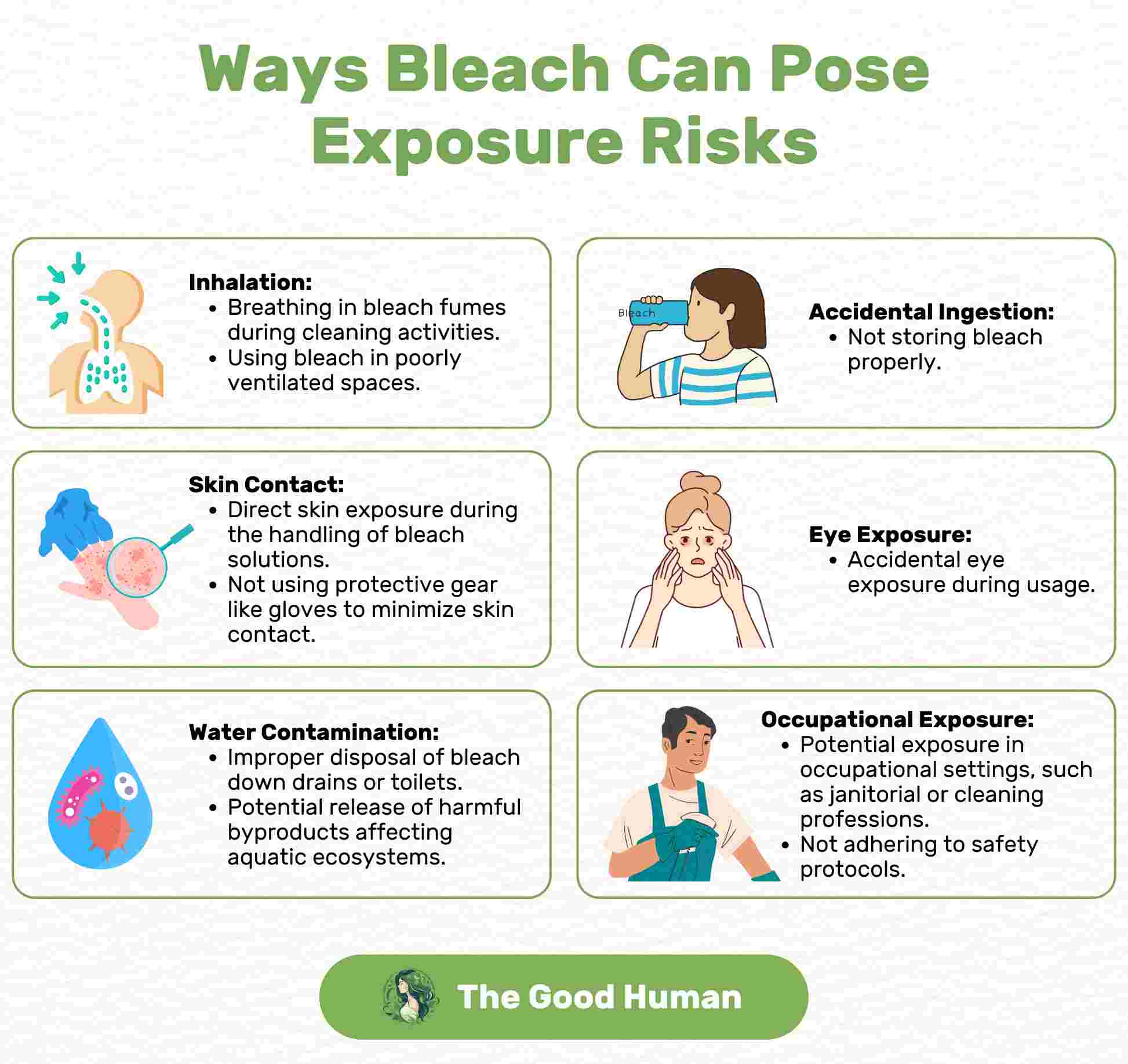
Inhalation Risks During Cleaning
As you’re scrubbing your bathroom with bleach, the pungent fumes fill the air and can pose risks if inhaled during cleaning. It is important to take precautions and follow safety measures to minimize potential health effects.
Inhalation of bleach fumes can irritate your respiratory system, causing coughing, wheezing, and throat irritation. Prolonged exposure may even lead to more serious respiratory problems.
To prevent these risks, ensure good ventilation by opening windows or using fans while cleaning with bleach. It is also crucial to wear protective gear like gloves and a mask to avoid direct contact with the chemicals and reduce the inhalation of fumes. Additionally, limiting the amount of time spent cleaning with bleach can further reduce exposure.
Skin Contact and Absorption Concerns
When it comes to cleaning with bleach, it is essential to follow precautions and safety guidelines to protect yourself from adverse effects.
Bleach contains chemicals that can cause skin irritation and even burns if proper care isn’t taken. It is important to wear protective clothing, such as gloves and long sleeves, when handling bleach to minimize the risk of skin contact. Additionally, those with sensitive skin should be especially cautious and consider using alternative cleaners that are less harsh.
Always read labels and instructions carefully to ensure safe usage of bleach.
Environmental Impact and Long-Term Exposure
Bleach contains chemical hazards that contribute to environmental pollution.
When bleach is washed down drains or enters bodies of water, it can harm aquatic life and disrupt ecosystems. Additionally, the production and disposal of bleach also contribute to air and water pollution.
Bleach has been found to have carcinogenic properties, which means it can potentially cause cancer with long-term exposure. Certain chemicals in bleach, such as sodium hypochlorite, can react with other substances present in the environment to form harmful byproducts like chloramines and trihalomethanes. These by-products are known to pose health risks when inhaled or ingested.
To minimize the environmental impact and long-term health effects of using bleach, safety precautions should be taken. This includes using bleach in well-ventilated areas and avoiding mixing it with other cleaning products or chemicals.
Bleach Regulations and Guidelines
Bleach regulations and guidelines in the United States are contingent upon the type of bleach and its designated purpose.
For household bleach, oversight primarily falls under the Federal Insecticide, Fungicide, and Rodenticide Act (FIFRA), administered by the Environmental Protection Agency (EPA). Compliance involves registration with the EPA, meeting stringent safety and efficacy standards, and adhering to labeling requirements encompassing usage instructions, safety precautions, and first-aid measures.
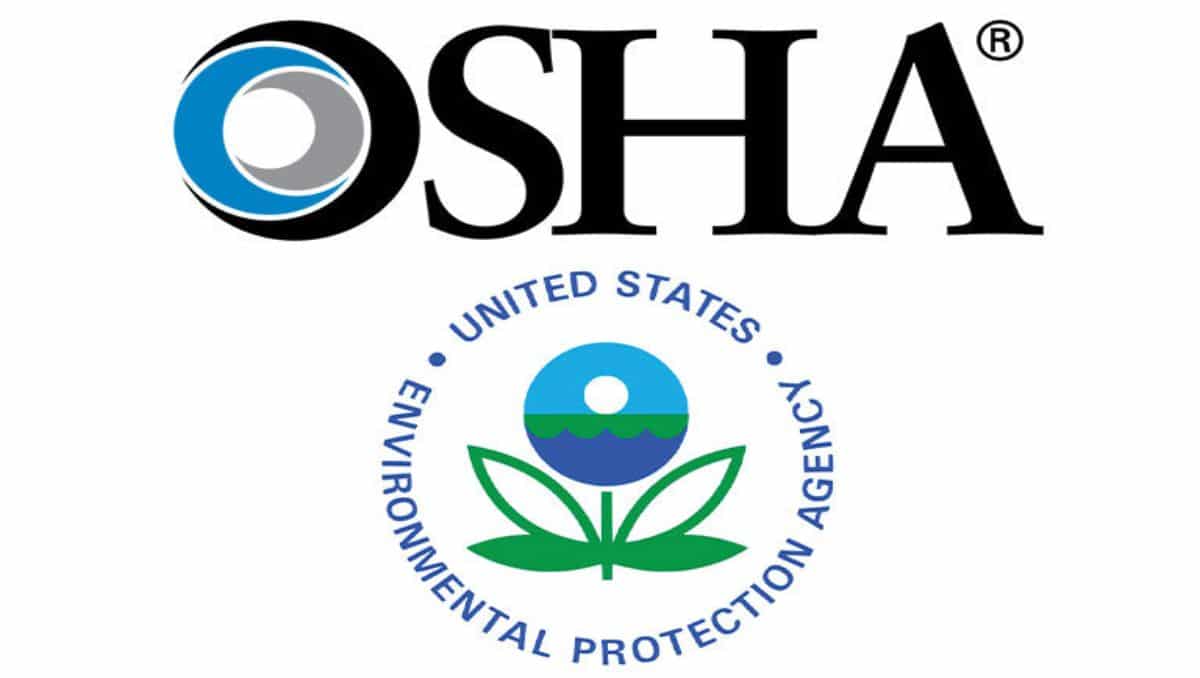
The Centers for Disease Control and Prevention (CDC) also supplements these regulations with additional guidelines for household use, offering insights into proper dilution ratios and ventilation recommendations.
For industrial bleach, regulations may encompass both FIFRA and other specifications contingent on its particular application. For instance, bleach employed in water treatment adheres to regulations outlined in the Safe Drinking Water Act under the EPA.
Industrial bleach typically adheres to more rigorous standards than its household counterpart due to its higher exposure potential, with specific regulations and standards varying based on industry and application.
The Food and Drug Administration (FDA), on the other hand, is primarily in charge of regulating healthcare bleach under the Food, Drug, and Cosmetic Act (FD&C Act). Compliance requires FDA clearance for specific medical uses with established standards for sterility, concentration, and safety.
Safe Practices for Minimizing Bleach Risks
When it comes to minimizing the risks associated with bleach, there are several safe practices that you can adopt.
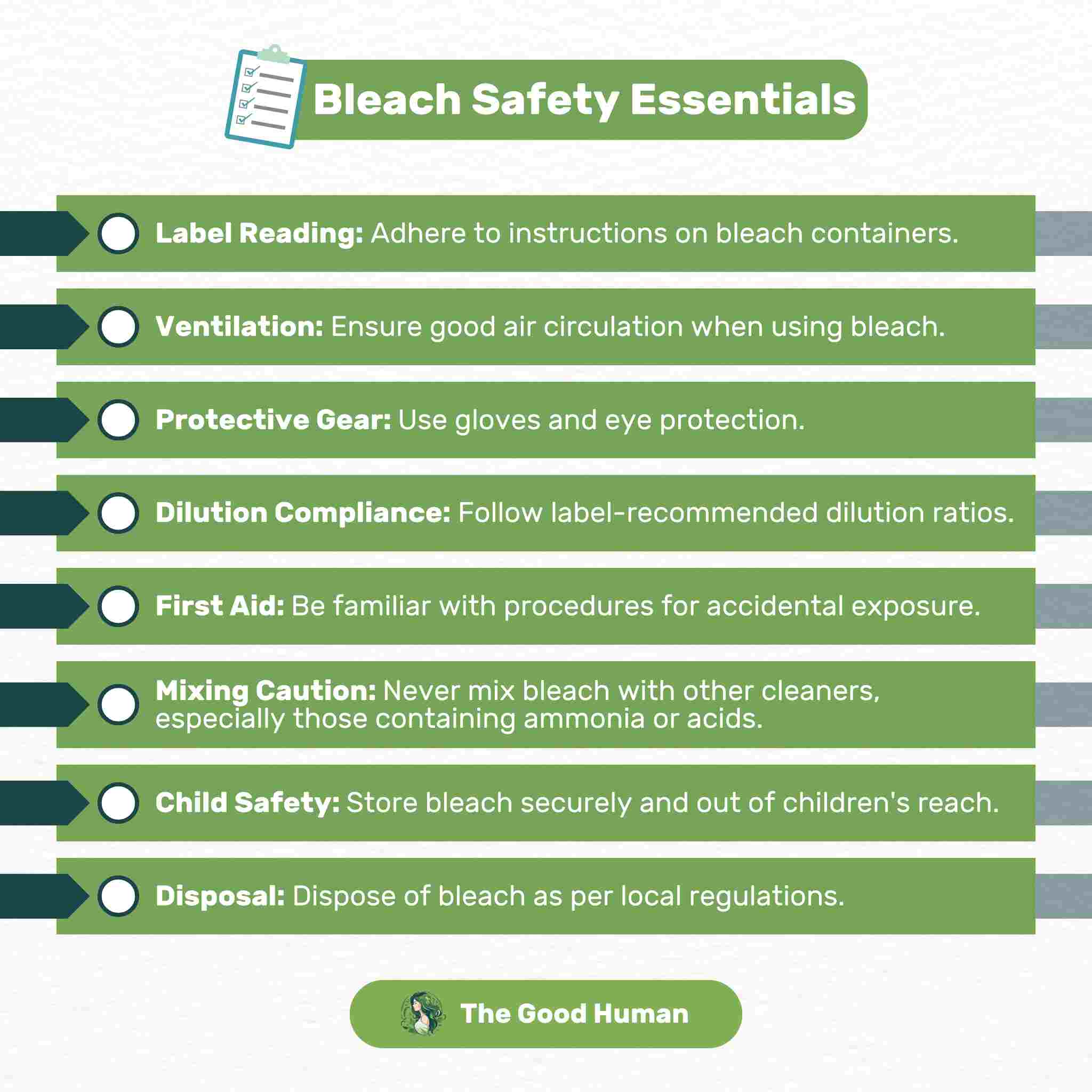
Alternative Cleaning Agents
Try using alternative cleaning agents that are less harsh on your health and the environment. Natural bleach alternatives, such as eco-friendly options and non-toxic cleaning products, can provide a safer way to clean without the risks associated with bleach.
Homemade cleaners made from ingredients like vinegar, baking soda, and lemon juice are effective at removing dirt and grime while being gentle on surfaces.
Green cleaning products that are certified by reputable organizations can also be a good choice, as they are specifically formulated to minimize environmental impact.
These alternatives not only reduce exposure to harmful chemicals but also contribute to a healthier indoor environment for you and your loved ones. Making the switch to these safer options is a small step towards creating a cleaner and more sustainable home.
“We definitely recommend people substitute with some DIY recipes instead of buying products off-the-shelf. Even a dash of dish soap with a bit of baking soda can help remove that scum off your sink or bathtub, and that can really help you to avoid some of the heavier, harsher chemicals,” said Samara Gell er, senior director of cleaning science at the Environmental Working Group, when asked in the New York Times.
Proper Dilution and Ventilation
To ensure a safe and effective cleaning process, remember to dilute cleaning agents properly and create proper ventilation in the area you are cleaning.
Proper dilution is essential to avoid any adverse health effects that may arise from using concentrated cleaning agents. Case studies have shown that improper dilution can lead to skin irritations, respiratory problems, and even chemical burns.
Ventilation techniques are equally important as they help remove any airborne chemicals that may be harmful when inhaled. Good ventilation includes opening windows or using fans to increase air circulation during the cleaning process.
You might also be interested in learning effective methods for eliminating bleach smell.
Protective Measures For Individuals with Heightened Cancer Risks
If you or someone you know has a higher risk of developing cancer, it is crucial to take extra precautions and implement protective measures when cleaning.
One important measure is to wear appropriate protective clothing, such as gloves and a mask, to minimize direct contact with cleaning chemicals.
Additionally, using air filtration systems can help remove airborne particles and reduce the inhalation of potentially harmful substances.
It is also recommended to choose cleaning tools that are specifically designed for individuals with chemical sensitivities, as they are often made from materials that minimize exposure to toxins.
The Final Verdict on Bleach and Cancer Risk
While definitive links are yet to be established, the surprising truth lies in acknowledging the potential health risks associated with bleach exposure. From inhalation concerns to skin contact and the environmental impact of improper disposal, it is clear that cautious use of bleach is paramount.
Whether opting for alternatives or employing stringent safety measures, we must have a balanced and safe approach to maintaining a clean and healthy household.

